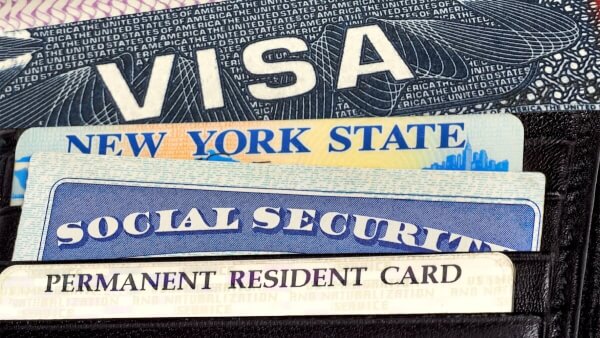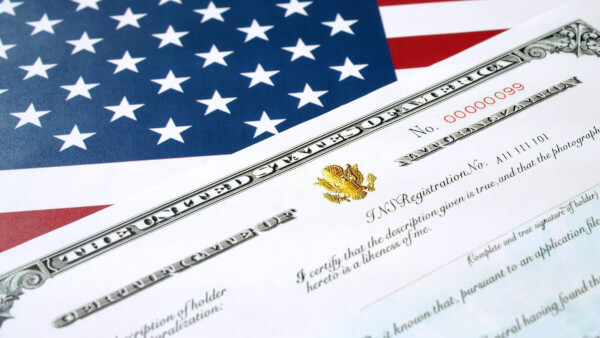Transferring your international driver's license to the US: step-by-step
Your full guide to updating your foreign driver's license to the US.

Green Card holders are granted the right to permanent residence (also called PR status) in the US. If you’re planning to settle in the US to live and work, a Green Card means you can stay as long as you like with more flexibility and greater freedoms than holding a visa or work permit. Getting a Green Card is also an important step to anyone hoping to naturalize as a US citizen.
This guide walks through the full employment Green Card process, including eligibility, application stages and interview preparation.
To help cut the costs of international transfers when paying for your Green Card we’ll also introduce Wise and the Wise Multi-currency Account for cross border payments which use the real exchange rate.
How to save money on international transfers
You may be eligible for an employment based Green Card if you’re working in the US on a permanent basis. Annually, around 140,000 employment based Green Cards are made available — although because the Green Card confers permanent residence it’s not usually appropriate for people doing work which is temporary or which will come to a natural end, such as post-doc research posts.
In most cases, your employer will need to sponsor you for your Green Card. Many employers will have their own criteria covering who they will and will not sponsor — you may need to be at a certain level within the organisation, or have been employed for a fixed period for example. If your employer agrees to sponsor your Green Card application, you’ll apply under one of the Green Card eligibility categories described below¹. The process will vary slightly based on whether you’re already in the US or not at the point of applying, but the steps — which we’ll cover in just a moment — are broadly similar.
It is technically possible to apply for a Green Card without an employer sponsor, if you fall into the EB-1 Extraordinary Ability category² or if you’re a second preference candidate³ with a National Interest Waiver.
The Extraordinary Ability category is very narrow and requires you to be among the very highest achievers in your field. You’ll need to demonstrate your achievements, such as winning national and international awards, commanding an unusually high salary for your position, or being written about in the mainstream media. Most successful applicants in this group will be national level sportspeople, performers or holders of prestigious awards like the Nobel Prize or an Oscar.
Securing a National Interest Waiver is also unusual, as you’ll need to show you have exceptional ability and also are coming to the US to do work which is in the national interests of the country.

The type of employment based Green Card you can apply for will depend on the type of work you do. Green Cards are split into different preference immigrant categories as follows:
The first preference category is EB-1, Priority workers². This category covers people of extraordinary ability, outstanding professors and researchers, and certain multinational managers or executives. If you’re applying under the extraordinary ability category you won’t need an employer sponsor, but you will need to demonstrate your achievements through extensive evidence. USCIS gives examples of this eligibility category as those holding an Olympic Medal, a Pulitzer Prize or similar — setting a pretty high bar for regular applicants.
This category also covers professors and researchers who have international recognition for their achievements and who are being offered a job with a private employer, and high level managers and executives coming to work in the US.
This Green Card category is for professionals with advanced level degrees, or foreign workers who can show they have exceptional abilities³. There is also a National Interest Waiver category in this priority group, which is used for people with exceptional ability coming to the US to carry out work which is in the national interest of the country.
To be granted a Green Card based on your advanced degree you’ll need to show you meet the labor code for the job you’ve been offered, and that you hold an advanced degree or another relevant qualification with 5 years or more of work experience. Getting a Green Card based on exceptional ability will require you to hit a range of criteria such as work experience, relevant qualifications, membership of professional bodies and recognition by your peers.
Priority 3 Green Card applicants can fall into the skilled, unskilled or professional categories⁴. In all cases you’ll need a labor certificate and a permanent, full time job offer to go down this route. Professionals will usually have a relevant degree, skilled workers will have at least 2 years of relevant work experience, and unskilled workers can cover anyone doing unskilled work which is not temporary or seasonal.
The priority 4 EB-4 Green Card category is a niche category for special workers, covering a diverse range of individuals including religious workers, those who have served in the US army, and some physicians⁵. To qualify under this category you’ll need to demonstrate your eligibility, based on the nature of your situation.
Individuals moving to the US to invest in businesses which will create jobs for US citizens may be able to apply for an EB-5 Investor Green Card⁶. At the time of writing there are changes being made to the investor program, but you can expect to need to invest between 500,000 USD and 1 million USD, and create 10 or more jobs for local people.
The process you follow to get a work based Green Card will depend on whether you are already in the US or not at the point you apply. If you are in the US and wish to move from a visa or work permit to a Green Card, you’ll need to follow the USCIS Green Card application process. People who are not yet in the US will have to apply through their local US consulate⁷ ⁸.
|
|---|
|
|---|
Depending on your situation you may be invited to an interview to discuss and demonstrate your eligibility for an employment based Green Card.
During the interview you may be asked to show your supporting evidence and documents, to establish the category of entrance you are eligible for. It’s important to prepare in advance for the interview, and to gather all the proof you may need according to your application type.
| Read also: the Green Card interview |
|---|
Immigration processes are often complex and can be daunting. Let’s take a look at some common questions related to the work based US Green Card process.
The number of Green Cards issued annually is limited across most categories, with additional limits based on nationality of applicants, which means that you may face a wait to get your employment based Green Card.
To check how long it will be before you can apply in full for your Green Card, take a look at the Visa Bulletin. Here you’ll find live information about which visa applications — by eligibility category and the nationality of the applicant — are being processed.
There are a range of fees involved in getting a Green Card. These include some fees your employer may have to pay, and other costs for your application¹², interview, biometric appointment, and any required medical checks. You may also want to budget extra for other costs such as travel to interviews and appointments, and your trip to the US once your Green Card is approved.
| Learn more: Green Card fees |
|---|
If you’re paying for your Green Card fees in a foreign currency, you need Wise. Wise offers low cost international payments which use the real mid-market exchange rate with no markups and no hidden fees. You can also get a free online Wise Multi-currency Account to hold and manage 50+ currencies, send and receive international payments, and spend easily as you travel.
If you’re already in the US and hold a valid visa, you’ll be entitled to remain in the country while your Green Card application is being processed. Whether or not you can work will depend on whether you have been granted work authorization previously. Check the full details online based on your specific visa type and personal situation to make sure you stay on the right side of the law¹³.
If you need to change jobs before your Green Card application is completed and approved you’ll want to understand the implications on your petition.
For the vast majority of employment based Green Card applicants, having an employer petition on their behalf is essential. If you then change employment, this sponsorship may be at risk. However, the process is complex and will depend on the reasons for the change in situation, the length of time your application has been pending, and whether or not the employer petition was approved prior to your moving roles.
Take specialist advice to check the impact a change of position may have on your Green Card application, so there are no surprises down the line.
Once you are granted a Green Card, you’ll want to check out your rights and responsibilities to ensure you can maintain your PR status¹⁴.
If you plan to leave the US for a year or more, you’ll usually have to apply for a re-entry permit before you go, to ensure you’re readmitted. If your stay abroad is longer than 2 years, your re-entry permit will expire and you’ll need to apply for permission to return to the US at your local consulate or embassy¹⁵.
Some Green Card holders are able to apply to have their spouse and unmarried children under the age of 21 come to the US with them. This is known as being a derivative applicant, as the legal basis for application derives from the original employment based Green Card.
Whether you’re already in the US, or applying to travel there with your work based Green Card, you need Wise.
Wise offers solutions for anyone living an international lifestyle. Get cross border payments with low fees and the mid-market exchange rate, and why not open a Wise Multi-currency Account which can be 6x cheaper than your regular bank?
Open your Wise account for free online and you can activate USD bank details to convert and receive payments like a local before you even arrive in the US. Hold and manage 50+ currencies, so you can send and spend money around the world for less.
Getting a work-based US Green Card means you can stay in the country on a permanent basis, without needing to change and update your visas and permits. It’s also a step on the road to becoming a US citizen.
Being approved for your Green Card is exciting — but can also be a lot of work. Use this guide as a reference point, take professional advice when you need it, and use all the resources available to you, to make sure your application goes through smoothly.
Sources:
Sources checked on 07.27.2021
*Please see terms of use and product availability for your region or visit Wise fees and pricing for the most up to date pricing and fee information.
This publication is provided for general information purposes and does not constitute legal, tax or other professional advice from Wise Payments Limited or its subsidiaries and its affiliates, and it is not intended as a substitute for obtaining advice from a financial advisor or any other professional.
We make no representations, warranties or guarantees, whether expressed or implied, that the content in the publication is accurate, complete or up to date.

Your full guide to updating your foreign driver's license to the US.

Whatever your reason is for moving to the US, this guide aims to help you figure out the most important costs you'll face when you live there.

Find all you need to know about getting a personal loan for H-1B visa holders in this guide.

Everything you need to know about the US certificate of naturalization.

The US welcomes large numbers of new arrivals every year — and getting a great job to both gain experience and set down roots is a core part of the American...

Find everything you need to know about the US citizenship test, including the USCIS questions and answers.